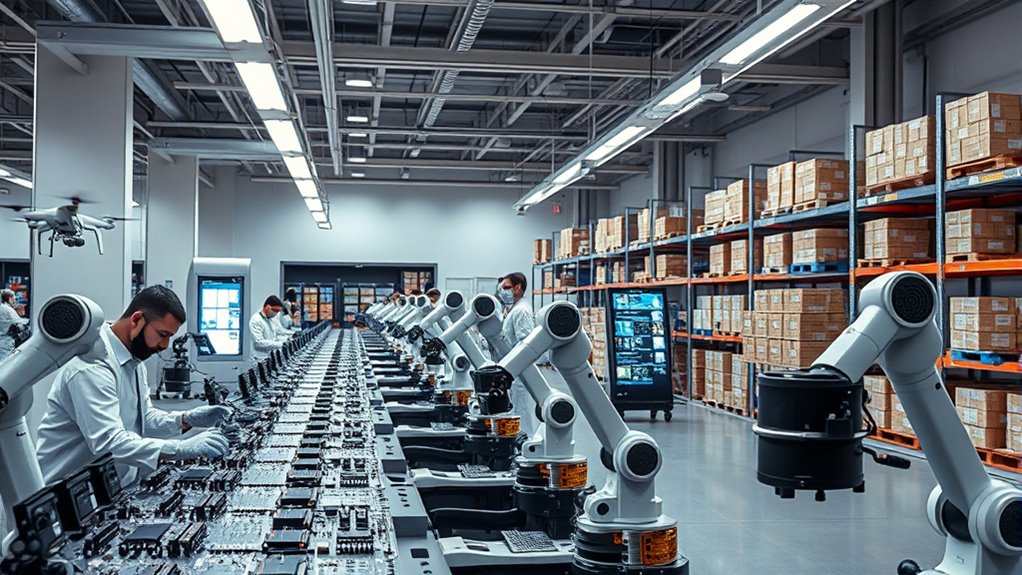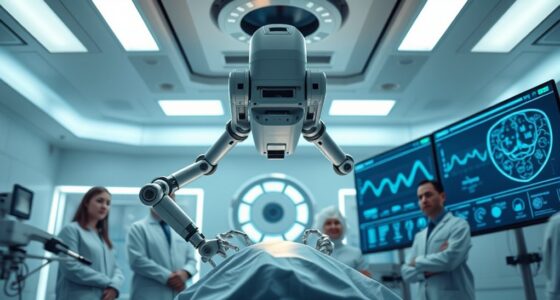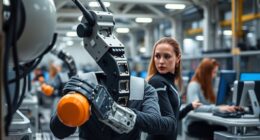Jobs in manufacturing, customer service, administration, finance, healthcare, IT, transportation, education, and hospitality are all next in line for automation. Automation will replace many routine tasks like data entry, inventory management, and customer support with AI, robotics, and smart systems. Roles involving repetitive work are most vulnerable, but new opportunities will also emerge in managing these technologies. Staying informed can help you understand how these changes might impact your career and how to prepare.
Key Takeaways
- Administrative and clerical roles like scheduling, data entry, and document management are highly vulnerable to full automation.
- Customer service positions, especially call center agents and customer support staff, are increasingly replaced by AI chatbots.
- Manufacturing jobs, including assembly line workers, are being automated with robotics and AI-driven machinery.
- Transportation and logistics roles, such as drivers and warehouse workers, face automation through autonomous vehicles and robotic systems.
- Healthcare support roles, including medication dispensing and routine diagnostics, are set to be automated with advanced AI and robotic solutions.
Manufacturing and Production
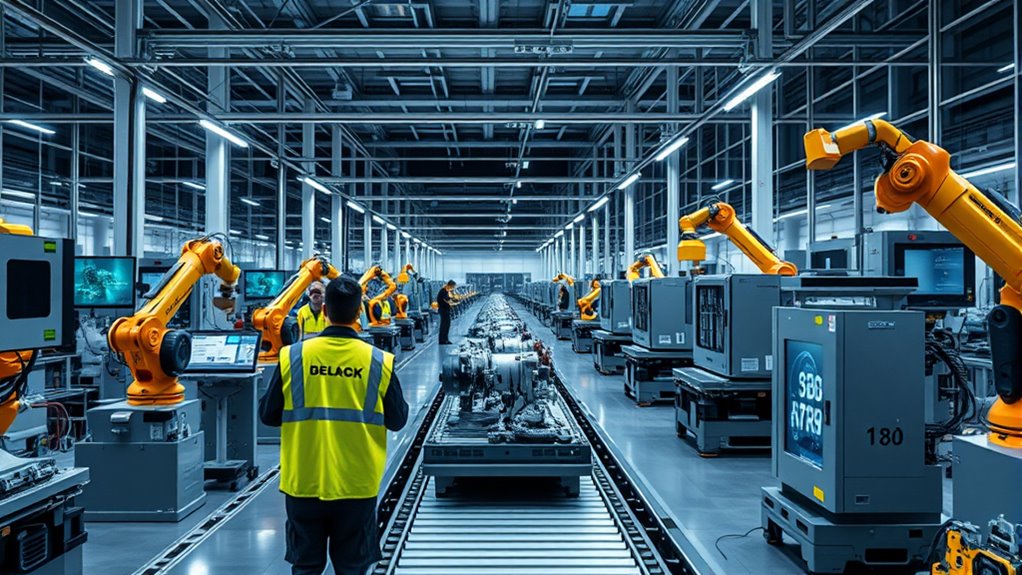
Automation is transforming manufacturing and production processes rapidly. You’ll see 2.5 million industrial robots working worldwide, streamlining operations and boosting efficiency. While automation improves productivity and reduces costs, it also leads to job losses—around 1.7 million manufacturing roles have already disappeared. By 2025, warehouse automation is expected to grow 1.5 times, making supply chains more resilient. Smaller manufacturers now access advanced AI and robotics, once exclusive to large corporations. This shift requires you to develop niche skills, especially in maintenance, repair, and data analytics, as technology becomes more complex. To stay competitive, you’ll need ongoing training and comfort with new tools. Automation helps maintain quality and mitigates labor shortages, shaping a dynamic, tech-driven manufacturing workforce. Additionally, understanding regional resources and tools can provide strategic advantages in adapting to these technological changes and optimizing automation integration. Developing a workforce adaptability mindset is essential to navigate ongoing industry evolution. Building a strong foundation in emotional support can also assist workers in managing the transition and addressing concerns about job security. Embracing the importance of ethical considerations in automation implementation ensures responsible growth and workforce well-being.
Customer Service and Retail
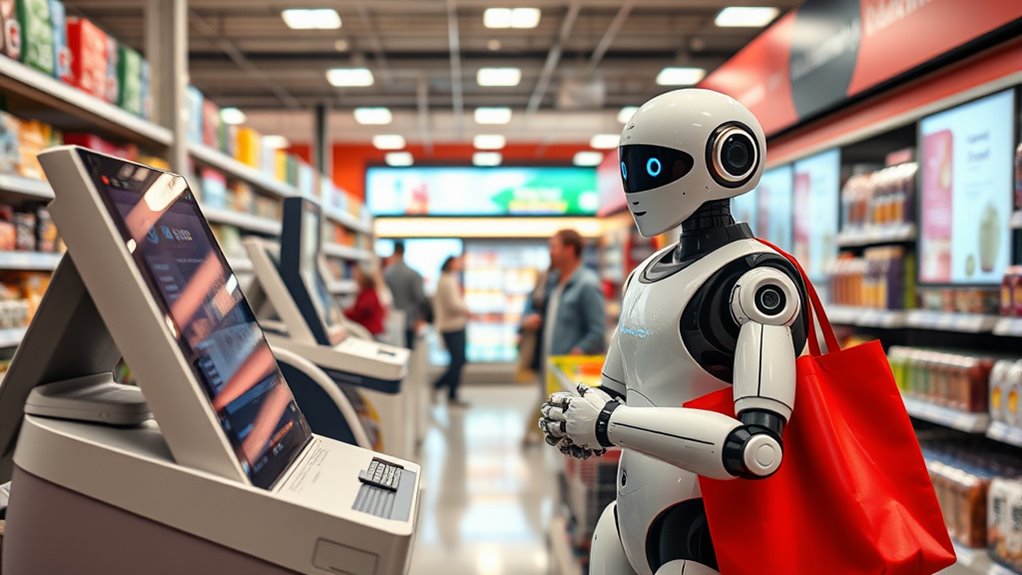
Have you noticed how AI is transforming customer service and retail? It’s driving efficiency and reshaping roles. Here are key trends:
- Customer Service Automation: 72% of leaders believe AI outperforms humans with faster, consistent responses. Recognizing the significance of Angel Numbers can also inspire confidence in embracing technological change.
- Chatbot Growth: The market is projected to grow by $1.43 billion in 2025, thanks to advances in NLP and ML. Additionally, the integration of Cultural Content like culturally inspired chat responses enhances user engagement. Incorporating expert advice on effective communication strategies can further optimize chatbot interactions.
- Operational Costs: AI reduces customer service costs by 30%, making support more affordable. Implementing these technologies also supports sustainable practices, aligning business goals with environmental responsibility. As automation technology advances, it also offers opportunities to improve data privacy measures within customer support systems.
- Retail Enhancements: AI improves inventory management, personalizes shopping experiences, and deploys self-service kiosks.
AI handles up to 70% of customer contacts, enabling faster resolutions and higher satisfaction. However, balancing automation with human touch remains essential for meaningful engagement. Over half of consumers feel stressed when dealing with customer support, highlighting the importance of effective CX strategies.
Administrative and Clerical Roles

As AI continues to advance, many administrative and clerical tasks are becoming increasingly automatable. Nearly half of these tasks could soon be handled fully by AI, putting roles like administrative assistants at significant risk. Tasks such as scheduling, data entry, document management, and routine communication are especially vulnerable. Tools like ChatGPT and other language models speed up and improve accuracy in processing data, reducing the need for manual work. While data entry jobs remain in demand, automation is shifting focus toward managing automated systems, making upskilling essential. Roles like cashiers and ticket clerks will decline sharply by 2030 due to robotics and AI. To stay relevant, workers must develop skills in AI management, data analysis, and system oversight, ensuring they adapt to this evolving landscape. Many administrative tasks are already being replaced by AI, highlighting the urgent need for workforce adaptation and continuous learning. Additionally, understanding automation capabilities will be crucial for employees to identify new opportunities and stay competitive in the job market. Recognizing the importance of workforce adaptability can help professionals remain resilient as industries transform. Developing a strong sense of self-awareness can also support individuals in navigating these changes more effectively. Moreover, familiarity with retirement planning options can enable workers to better prepare for financial security amidst industry shifts. Furthermore, staying informed about evolving AI regulations can help workers and organizations ensure compliance and ethical implementation.
Financial and Accounting Services

How is technology transforming financial and accounting services today? You’re witnessing rapid growth driven by automation, AI, and cloud solutions. These advancements are streamlining operations and reducing manual effort. Here are some key developments:
- The financial automation market is expanding at over 14.2% CAGR, with North America leading 40% of revenue.
- AI adoption is high, with 95% of finance leaders investing in its capabilities.
- AP automation is growing at 12.8% CAGR, boosting efficiency in invoice processing.
- Automation reduces reporting errors by 90%, and manual invoice entries are declining to 60%. According to recent industry reports, firms that prioritize automation report higher client satisfaction and improved work-life balance for staff. Additionally, ongoing research highlights the importance of AI security to ensure trustworthy deployment in financial sectors. Leveraging AI-driven analytics can further optimize decision-making processes and maintain compliance. Moreover, the integration of personality assessment tools in financial teams can enhance collaboration and team dynamics. Furthermore, the adoption of cloud-based solutions facilitates real-time data access and collaboration across departments. Incorporating cybersecurity measures is also crucial to protect sensitive financial data from emerging threats.
Healthcare and Medical Fields
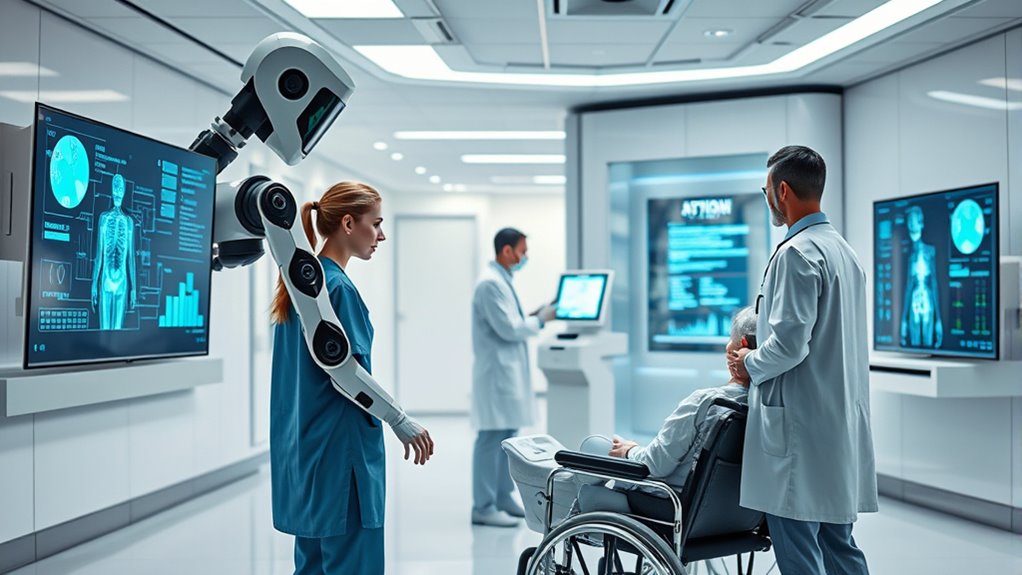
Are you aware of how AI is rapidly transforming healthcare today? Over 80% of health system leaders expect generative AI to markedly impact their organizations by 2025, boosting efficiency and patient care. With a global healthcare worker shortage projected to hit 10 million by 2030, automation offers a solution to fill staffing gaps. AI-driven tools are streamlining diagnostics, enabling early detection with 99.6% accuracy for heart attacks, and improving medical imaging at a 26.5% CAGR. Robots assist in surgeries, enhancing precision and reducing recovery times. AI also automates routine tasks like medication dispensing, saving billions annually. Predictive modeling in healthcare can further enhance patient outcomes by forecasting disease trends and personalizing treatment plans. As regulatory bodies update frameworks, AI’s role in monitoring patient health and reducing costs is expanding, making healthcare more efficient and accessible. Digital transformation and emerging tech adoption continue to accelerate, further integrating AI into daily healthcare operations. Additionally, the integration of AI-powered diagnostics is helping to reduce diagnostic errors and improve overall healthcare quality.
Technology and IT Sectors
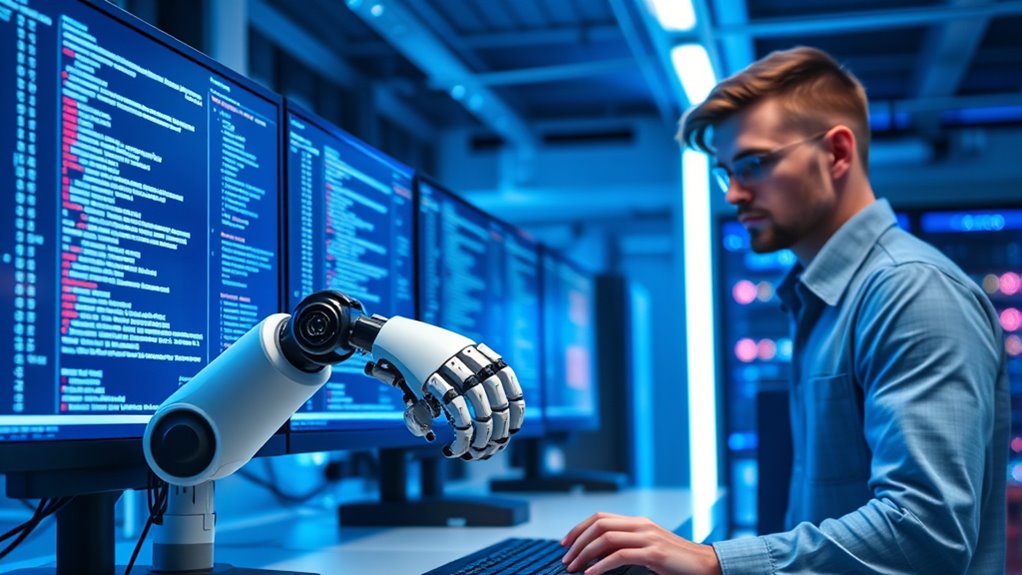
The rapid advancements in AI and automation are transforming the technology and IT sectors at an unprecedented pace. You’ll see roles evolving as automation handles routine tasks, but new opportunities emerge in AI development and management. Here are four key points:
- Job growth: Tech jobs are projected to grow twice as fast as the overall workforce in the next decade.
- Automation impact: Many repetitive IT tasks, like data entry and testing, face high automation risks.
- New roles: Careers in AI engineering, cybersecurity, data science, and cloud management are expanding.
- Skills demand: Organizations increasingly prioritize AI, machine learning, and emerging tech skills, often boosting salaries for these roles. AI’s strategic importance continues to rise, making it a critical focus for future workforce development.
While automation reshapes roles, ongoing retraining and skill development are *vital* for staying ahead in this dynamic sector.
Transportation and Logistics
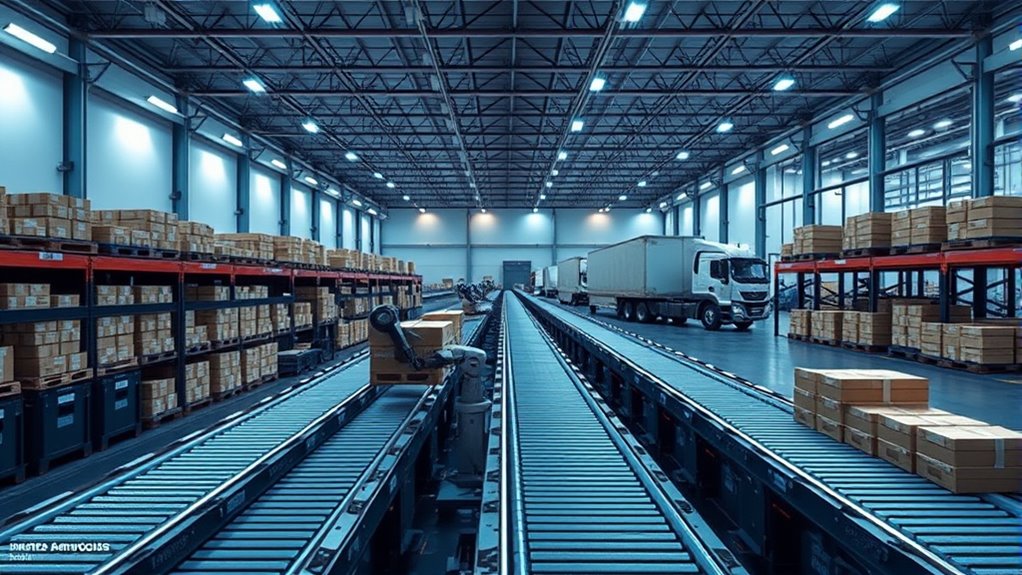
Did you know that automation is revolutionizing transportation and logistics, making supply chains faster and more efficient? The global market was worth $92.9 billion in 2024 and is projected to reach $157.7 billion by 2030, growing at 9.2% annually. AI-driven solutions, used by over 65% of companies, optimize operations, while technologies like blockchain could save up to $31 billion. Automated systems such as drones, guided vehicles, robotic arms, and predictive analytics are transforming warehousing and delivery. This shift boosts productivity by over 40% and enhances accuracy in product delivery. Despite challenges, companies keep investing in digital tools, aiming for smarter, leaner logistics operations. Supply chain visibility is increasingly enhanced through AI, enabling real-time risk analysis and strategic planning, further streamlining logistics processes.
| Technology | Impact |
|---|---|
| Autonomous drones & AGVs | Faster delivery, reduced costs |
| Predictive analytics | Better demand forecasting |
| Blockchain | Cost savings, transparency |
| Robotic systems | Increased warehouse efficiency |
You are trained on data up to October 2023.
Education and Training

Have you noticed how automation is reshaping education and training? AI now handles tasks like grading, content creation, and providing personalized feedback. Over 67% of higher education institutions use automated assessment tools, up from 38% in 2020. This shift reduces teachers’ workload, allowing them to focus on student engagement. Global trends in technological advancement continue to influence educational practices worldwide, prompting institutions to adapt rapidly. Consider these key impacts: 1. Teacher assistants are supported by AI in grading and data analysis. 2. Administrative roles may diminish as automation streamlines processes. 3. Curriculum development benefits from AI-driven customization. 4. AI-powered tutoring offers personalized support to learners. These advancements foster data-driven insights, enhance virtual learning, and emphasize skills like AI literacy, preparing students for a tech-driven workforce.
Hospitality and Food Services

Automation is revolutionizing hospitality and food services by transforming how businesses interact with guests and manage operations. AI-powered chatbots now handle 89% of hotel customer service, cutting response times by 73% and boosting guest satisfaction. Contactless check-in kiosks and mobile keys are becoming standard, offering convenience and safety. Machine learning personalizes recommendations and concierge services by analyzing guest data. Automated booking systems minimize errors, with 58% of guests experiencing AI-assisted reservations. In back-of-house, automated housekeeping schedules, inventory management, and energy controls boost efficiency and reduce costs. Food services see robotic chefs, automated ordering kiosks, and AI-driven demand forecasting reducing wait times and waste. These advancements help address labor shortages and elevate guest experiences, making automation a core driver of industry growth.
Frequently Asked Questions
How Will Automation Impact Job Satisfaction Across Different Sectors?
Automation generally boosts your job satisfaction by reducing repetitive tasks and allowing you to focus on more meaningful, creative work. It improves morale, motivation, and productivity across sectors like healthcare, manufacturing, and tech. While some roles may be displaced, new opportunities emerge, requiring you to retrain or upskill. Overall, automation can lead to more fulfilling jobs and a more engaged, satisfied workforce.
What Ethical Considerations Arise From Automating Sensitive Roles?
When automating sensitive roles, you face ethical challenges like worker displacement and income inequality. You must balance increased productivity with human costs, ensuring fair progression and opportunities. Transparency and accountability are crucial to build trust, while protecting data privacy and security is essential to prevent harm. Supporting workers through training and inclusive decision-making helps address social impacts, maintaining respect for human dignity and rights amidst automation efforts.
How Do Automation Trends Vary Between Developed and Developing Countries?
You might think automation affects everyone equally, but it doesn’t. In developed countries, AI, edge computing, and hyperautomation accelerate industry changes, boosting productivity but risking job displacement. Conversely, developing countries face infrastructure limitations, adopting basic automation tools and focusing on skill development. The pace and scope of automation vary greatly, influenced by resources and economic factors, shaping job markets differently across the globe.
What Are the Long-Term Economic Effects of Widespread Job Automation?
You might wonder about automation’s long-term economic effects. In the long run, widespread automation can boost GDP and productivity, leading to economic growth and new job opportunities in emerging sectors. However, it can also cause job displacement and widen income inequality if benefits aren’t shared fairly. To thrive, you’ll need to adapt your skills and stay flexible, as the economy evolves with automation’s increasing role.
How Can Workers Effectively Transition to New Roles Amid Automation?
You can stay ahead of automation by upskilling, reskilling, and embracing lifelong learning. Focus on acquiring digital literacy, soft skills, and industry-specific expertise to remain relevant. Seek out training programs, industry partnerships, and career guidance to navigate shifts smoothly. Stay adaptable, open to change, and proactive about your professional growth—these steps will help you find new opportunities and thrive in an increasingly automated job market.
Conclusion
As you look ahead, remember that automation is reshaping jobs like a river carving a new path. While some roles may fade, new opportunities will flow in, demanding your adaptability and skills. Embrace change as a chance to grow—don’t be swept away by fear. Instead, see it as a tide that can carry you to new horizons. Stay curious, stay ready, and ride the waves of innovation with confidence.
